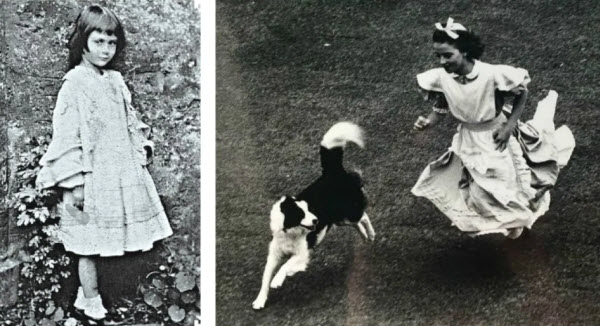The stories of Alice’s Adventures in Wonderland are among the most influential novels ever written, created by Charles Lutwidge Dodgson. They have captivated both children and adults, narrating the adventures of a bored young girl named Alice who journeys to a fantastical parallel world filled with amusing, human-like creatures. Given the immense success of these tales, it was only natural for filmmakers to bring them to the screen, further endearing them to audiences. However, what is less known is that the novel, which is a notable example of the literary genre known as “absurdist literature,” owes its inspiration to a real ten-year-old girl named Alice Liddell. Her story, which inspired Dodgson to write the book, is worth recounting.
Charles Dodgson, also known as Lewis Carroll, was a mathematician, photographer, deacon, and author born on January 27, 1832, in Daresbury, Cheshire, England. A talented child, he demonstrated his intelligence early on, reading books by the age of seven. He received his early education at home and later attended Richmond Grammar School. Despite facing various health issues in his youth, including partial deafness and respiratory problems, Dodgson’s mind was exceptionally sharp, and he had a remarkable imagination. He was reportedly afflicted with a rare neurological disorder that distorted reality, causing him to see things larger or smaller than they were. Naturally, this condition made it easier for him to imagine and create the vivid fantasies found in Alice’s Adventures in Wonderland.

Dodgson wrote Alice’s Adventures in Wonderland under the pseudonym “Lewis Carroll.” The story began three years before the book was published, on July 4, 1862, during a boating trip on the Thames River with Reverend Robinson Duckworth and three young girls: Alice, Edith, and Lorina Liddell. During the trip, ten-year-old Alice Liddell asked Dodgson to tell a story. He obliged, recounting the tale of a young girl named Alice who falls down a rabbit hole into a fantastical world. The girls loved the story, and Alice asked Dodgson to write it down. He promised to do so, and a few months later, fulfilled his promise, creating the story that became a beloved classic.

On November 26, 1864, Dodgson presented Alice Liddell with a manuscript titled Alice’s Adventures Under Ground, which included original illustrations by him. A year later, in November 1865, the book was officially published and achieved immediate success. Lewis Carroll became a household name, and even Queen Victoria became an ardent admirer, requesting that Dodgson dedicate his next book to her. As Dodgson was a mathematician, his next book was a mathematical treatise titled A Preliminary Memoir on the Determinants with Applications to Simultaneous Linear Equations and Algebraic Equations, which he indeed dedicated to the queen, who greatly enjoyed it.

Later, Carroll wrote a sequel featuring Alice, titled Through the Looking-Glass, and What Alice Found There, which was officially published in 1871. Five years earlier, in 1866, he had sent the original manuscripts of this sequel to Alice Liddell. In 1890, Carroll published a condensed version of the book with additional illustrations for children under five years old.
Charles Dodgson passed away on January 14, 1898, having published at least fifteen books, none of which reached the fame of Alice’s Adventures in Wonderland. All this was thanks to a young girl, Alice Liddell, with whom Dodgson was friends, taking them on outings, telling them stories, and photographing them, a hobby he cherished until their relationship ended in 1863 for unknown reasons. Some biographers speculate that Dodgson had romantic feelings for Alice and wished to marry her, while others suggest that Alice’s older sister Lorina was in love with Dodgson, leading him to cease contact with the family. However, this remains a mystery, as Dodgson’s diaries from this period are missing, and the photos were burned.

As for Alice Liddell, the inspiration behind Alice’s Adventures in Wonderland, she was the fourth child in the Liddell family, born on May 4, 1852. She had nine siblings and was regularly accompanied by her sisters Edith and Lorina. The three of them traveled to Europe when Alice was young. She later married Reginald Hargraves, an English cricketer, at the age of 28, and they had three children: Alan, Leopold, and Caryl. The first two died as soldiers in World War I, while Caryl survived and started his own family. Reginald Hargraves passed away in 1926, leaving Alice alone with the high maintenance costs of her estate. As a widow, she was forced to sell the original manuscript of Alice’s Adventures Under Ground, which had been a gift from Lewis Carroll, fetching £15,400—four times more than Sotheby’s had anticipated. The manuscript was later purchased by American businessman Eldridge R. Johnson and exhibited at Columbia University in the United States. Alice, then 80 years old, was invited to the presentation where she had a fascinating encounter with Peter, the inspiration for J.M. Barrie’s famous novel Peter Pan. Her book was eventually bought by a group of American book lovers and returned to the British public as a reward for their bravery during World War II. Today, the manuscript is held in the British Library, the second-largest library in the world. Alice passed away on November 16, 1934, at the age of 82, and her remains are interred in a cemetery at St. Michael’s Church in Hampshire.

Despite the differences between the Alice in the illustrations of Alice’s Adventures in Wonderland and Alice Liddell, it is clear that Dodgson had Miss Liddell in mind when creating his character. To this day, approximately 100 million copies of the book have been sold, and numerous films have been made based on the novel. Interestingly, one of these adaptations was banned in China in 1931 on the grounds that animals should not use human language.
